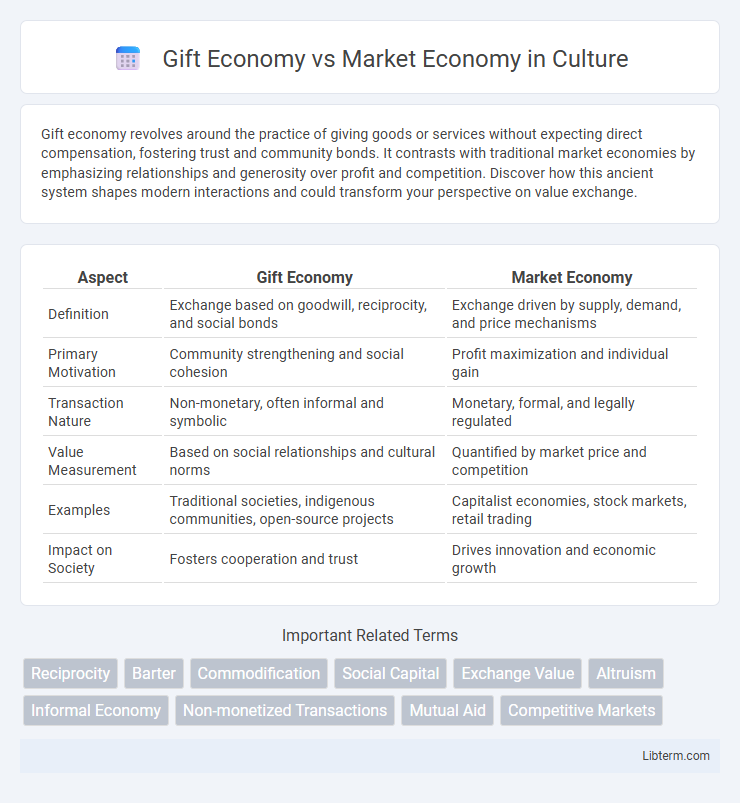Gift economy revolves around the practice of giving goods or services without expecting direct compensation, fostering trust and community bonds. It contrasts with traditional market economies by emphasizing relationships and generosity over profit and competition. Discover how this ancient system shapes modern interactions and could transform your perspective on value exchange.
Table of Comparison
| Aspect | Gift Economy | Market Economy |
|---|---|---|
| Definition | Exchange based on goodwill, reciprocity, and social bonds | Exchange driven by supply, demand, and price mechanisms |
| Primary Motivation | Community strengthening and social cohesion | Profit maximization and individual gain |
| Transaction Nature | Non-monetary, often informal and symbolic | Monetary, formal, and legally regulated |
| Value Measurement | Based on social relationships and cultural norms | Quantified by market price and competition |
| Examples | Traditional societies, indigenous communities, open-source projects | Capitalist economies, stock markets, retail trading |
| Impact on Society | Fosters cooperation and trust | Drives innovation and economic growth |
Introduction to Gift Economy and Market Economy
Gift economies operate on reciprocal exchange without explicit monetary valuation, emphasizing social bonds and community trust. Market economies rely on supply and demand mechanisms, where goods and services are exchanged for money, driven by individual profit motives. The fundamental contrast lies in the role of money and social intention shaping economic interactions.
Key Principles of Gift Economy
Gift economy operates on the key principles of reciprocity, community bonding, and social cohesion, where goods and services are given without explicit agreements for immediate or future rewards. This system fosters trust and mutual support, emphasizing relationships over profit and competitive exchange. Unlike market economies driven by supply, demand, and price mechanisms, gift economies prioritize altruism and the strengthening of social networks.
Core Concepts of Market Economy
Market economy operates on the principles of voluntary exchange, private property rights, and the price mechanism that balances supply and demand. Firms and consumers make decentralized decisions based on profit motives and preferences, driving efficient resource allocation and innovation. Unlike a gift economy, market economy relies on monetary transactions and competition to coordinate economic activities and incentivize productivity.
Historical Evolution of Both Economies
Gift economies originated in ancient communal societies where reciprocal exchange reinforced social bonds, predating the rise of formalized market systems. Market economies evolved with the development of trade networks and currency, facilitating complex transactions based on supply and demand principles during the agricultural and industrial revolutions. The historical transition from gift-based reciprocity to market-driven exchange reflects broader societal shifts from kinship ties to impersonal economic relationships.
Social Relationships and Community Impact
Gift economies strengthen social relationships by fostering trust, reciprocity, and collective well-being, creating resilient and interconnected communities. Market economies prioritize transactions and individual gain, often weakening communal bonds through competitive and profit-driven exchanges. In social contexts, gift economies enhance community impact by encouraging cooperation and long-term social investment rather than purely economic returns.
Resource Allocation and Distribution Mechanisms
Gift economies allocate resources through communal sharing based on social relationships and reciprocity, which fosters trust and cooperation without formal market transactions. Market economies rely on supply and demand dynamics where prices signal resource scarcity and guide the distribution via voluntary exchanges and competitive markets. The efficiency of market mechanisms enables rapid adjustment to consumer preferences, while gift economies emphasize equitable access and social cohesion over profit maximization.
Advantages and Disadvantages of Gift Economy
Gift economies foster community bonds and encourage altruism by promoting the free exchange of goods without monetary compensation, enhancing social cohesion and trust. The lack of formal pricing mechanisms can lead to inefficiencies in resource allocation and difficulties in sustaining large-scale production or meeting diverse individual needs. Challenges include potential imbalances in giving and receiving, which may create social pressure or resentment, limiting economic scalability compared to market economies driven by supply and demand dynamics.
Strengths and Weaknesses of Market Economy
A market economy excels in efficiently allocating resources through supply and demand dynamics, fostering innovation and consumer choice while driving economic growth. However, it often leads to income inequality, market failures, and under-provision of public goods due to profit maximization priorities. Lack of regulation can result in negative externalities such as environmental degradation and exploitation of labor.
Real-World Examples and Case Studies
The gift economy thrives in indigenous communities like the Maori of New Zealand, where resources and services are exchanged without explicit agreements, fostering social cohesion and mutual support. In contrast, the market economy dominates modern capitalist societies, exemplified by the United States, where goods and services are traded based on supply, demand, and price mechanisms, driving innovation and economic growth. Case studies of open-source software communities, such as Linux, illustrate hybrid models where gift economy principles coexist within market-driven frameworks, blending altruism with commercial incentives.
Future Perspectives: Integration and Hybrid Models
Future perspectives on Gift Economy and Market Economy emphasize the emergence of hybrid models that blend altruistic exchanges with market mechanisms to enhance sustainability and social cohesion. Integrating digital platforms and blockchain technology facilitates transparent value tracking and trust-building, promoting collaborative consumption alongside traditional transactions. These innovations suggest a shift toward economies that balance profit motives with communal well-being, fostering resilient and adaptive systems for the future.
Gift Economy Infographic

 libterm.com
libterm.com